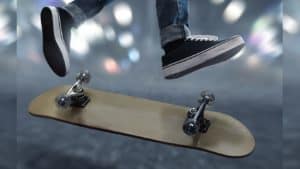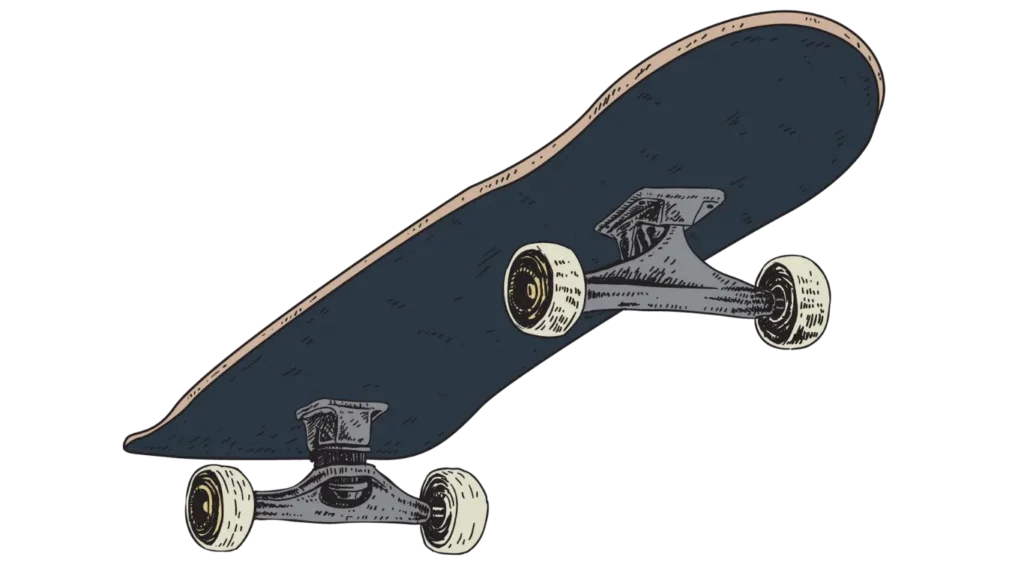
How to Tell the Front and Back of a Skateboard?
- Ed Riley
- October 26, 2022
questioned whether the deck of your skateboard had a front and a back? If this is something that has occurred to you, then we can provide the solution. In fact, the front of a skateboard is called the nose. They also possess a tail-like back.
You can figure out which side of your skateboard deck is the front or rear using a few different methods. The nose or front of tEver he skateboard is significantly taller and longer. The skateboard’s rear or tail, on the contrary, is substantially shorter. Read on to learn more about the front or back of your skateboard.

The nose and tail of a skateboard may be discernible. But it’s also important to understand that not all of them are made in the same way. The three different varieties of skateboard deck forms are single or flat noses, cruisers, and double kicks. Figure out how to determine the skateboards’ nose and tail shapes without further ado.
Understand the contours and structure of your skateboard deck first. Everything starting from the nose, tail, bearing, and other components must be understood.
First, put your skateboard on a level surface. To comprehend the skateboard’s form and contours, raise it to eye level. The incline of one side should be greater than the other. The nose of the skateboard is located where the gradient is steeper and lengthier.
You might even use a measuring tape in order to get precise study results. Simply use a measuring scale or measuring tape to gauge the skateboard’s front or rear ends.
From the edge of the board to the screw hole, measure the length of the deck. There must be two readings of varying lengths, one of which must be longer than the other. For instance, if the measurement is 10 inches and 4 inches, the front of the nose is 10 inches long. The tail has a length of 4 inches.
You could find it easier to distinguish between the front and back of a skateboard if the hardware is made up of several different colours. For instance, you can quickly determine which is the front or back of the skateboard deck if you use multi-colored bolts on the front and back of the deck.
You may also add wheels of various colours to the front and rear. Your skateboard’s back wheels, for instance, can be all black. On the contrary, one of your skateboard’s front wheels may be a different shade of the colour wheel.
You will be able to tell which wheel is situated at the front or back of your skateboard deck if it has a different colour combination.
On one side of the skateboard, typography or a brand name are frequently printed. The brand name or typography may appear on the front or rear of the skateboard. Keep in mind the positioning of the brand name or the font type and colour to establish which side is the back and which side is the front.
Skateboards need a typical distinguishable nose and a tail. The skateboard’s tail is nearer to the ground. This enhances the performance of the skater as it ensures a better popping.
There are also some easily distinguished features of the nose and tail of the skateboard. For instance, the nose may be bigger while the tail is shorter.
Thus, it is important to identify the nose and tail of the skateboard. This is because clear distinguishable features and identification can aid you to perform different kinds of tricks.
Moreover, skateboards need a typical nose and a tail because the uniqueness in their shape decides whether the skater will glide forward or not. For example, the nose end of the deck is bigger, but the tail is much shorter. Some riders also use the front or the nose as the main side, which is why knowing the sides is important.
The nose and tail of a skateboard are made differently because you use your front and back foot for different things. Your major foot is your stronger back foot, which you frequently use to bust a deck. Popping the deck is made easier by the nose’s longer and steeper angle. You use your front foot for flipping methods since it’s usually quicker.
You often fall on your back foot while skating regularly. Unless you’re doing a trick like an ollie, you don’t often ride with your front foot on the nose. A shorter tail pops in less time since it is closer to the ground. If the nose is longer and steeper, you may flip your board faster.
The fundamental distinction between the deck’s front and rear or nose and tail is size. The nose or front of vintage skating decks is larger and longer. The tail side, on the contrary, is smaller and has a lower incline or slope.
It’s crucial to bear in mind, though, that the information provided here applies to basic skateboards only. Some manufacturers like making their skateboards in unique ways. In the instance of the nose and tail for certain skateboard manufacturers, you could even observe the reverse scenario.
The front may be used for forward glides, while the rear can be used for reverse glides, depending on your desire.
Skaters who are very picky about using the rear of the board for tricks like ollies exclusively skate on that side. Many skaters switch sides often. Doing this is beneficial because it reveals which side of the deck facilitates more effortless forward motion. Additionally, less wear and tear will occur on one side if all sides or ends are used.
You may do manoeuvres like thrusts on a bidirectional skateboard from either side of the deck. You should also ignore those who insist you should never strike from the back of the deck. You may perform certain tricks far more smoothly if you make use of the tail of your deck.
When selecting a side of the deck, keep in mind the sort of trick you want to perform.
Skateboards have decks in a variety of designs and styles. One of them is the twin-style skateboard deck. You may have purchased a twin-style skating deck if you find that the front and rear of your board have an identical design. You know you have a twin-style skating deck if there is no visible feature on either side of the board to indicate which is the back or the front.
Skateboards with a “twin” design feature decks which are identical in size, shape, and angle on both the front and rear. Alternately, this is called a “double kicktail,” which is distinct from “twin-style” decks.
Whether or not a twin-style deck appeals to you will depend on your taste. Some people really like having a twin deck, while others really dislike it. But there is an advantage to this kind of deck. The tail of your skateboard bears the brunt of your weight, so it will last longer.
If you can pop one of the deck’s tails or both of its sides, the deck will live considerably longer. You have to kick the tail of the deck harder into the ground in order to do a flip. As a result, flips may be quite simple to execute on twin-style decks.
We have some parting remarks on the front and rear of your deck that we’d want to discuss before we go. Skating may be enjoyable, and if you haven’t chosen which side you’ll utilize, that’s alright too!
Never forget that the skateboard’s front and rear sides could be different from one model to the next. But it shouldn’t stop you from enjoying skateboarding for all its worth. Regardless of which side of the deck you choose to skate on, you’ll be able to enjoy the sport for what it is: a fun way to engage your body and mind.
Skate Insider is a participant in the Amazon Services LLC Associates Program, an affiliate advertising program designed to provide a means for sites to earn advertising fees by advertising and linking to Amazon.com
